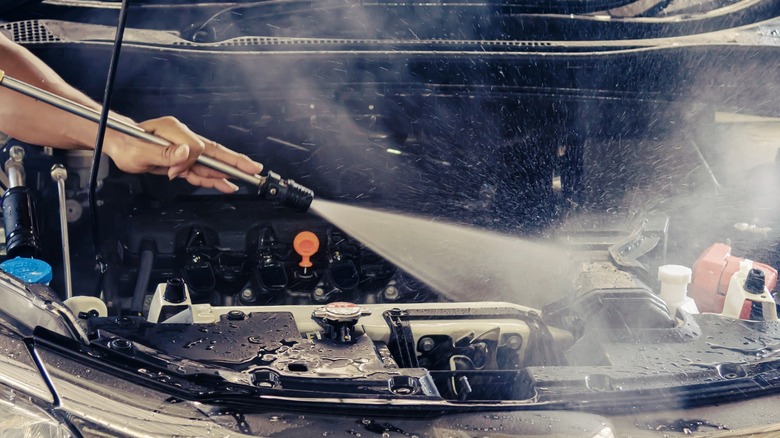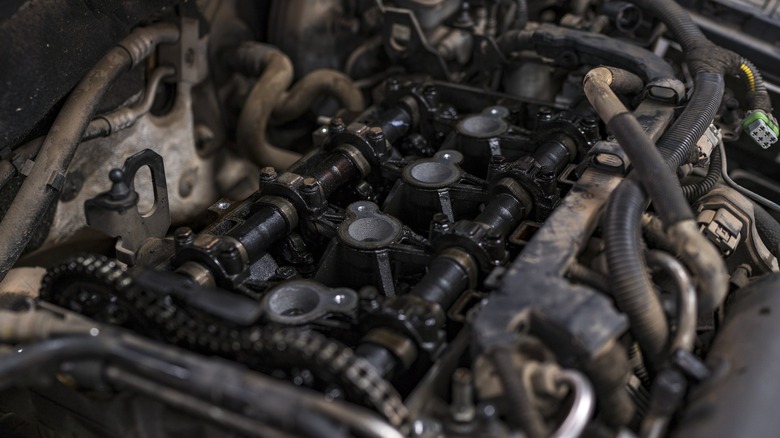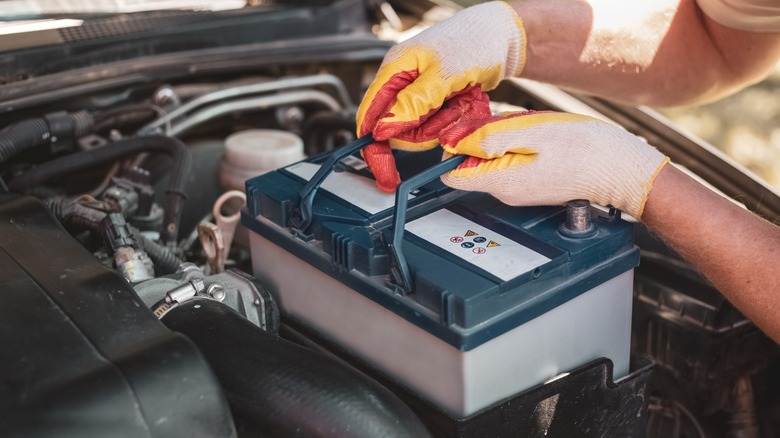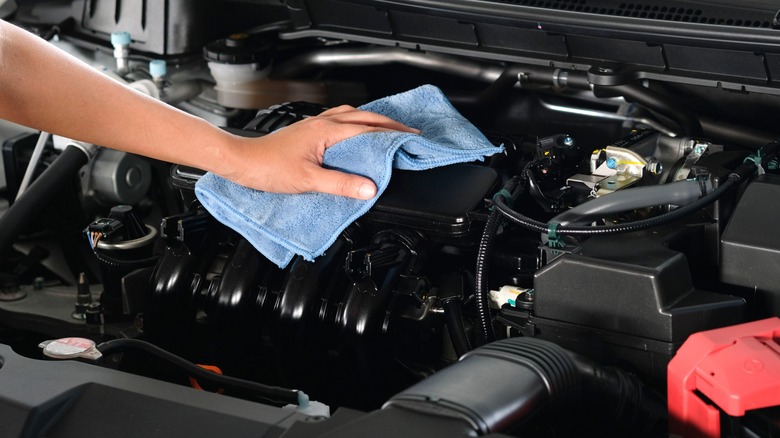Is It Safe To Use A Pressure Washer To Clean Your Engine? What To Know
If you're the type that loves to keep a clean car, chances are you've popped the hood and given your engine a thorough scrubbing. From degreasing to gingerly rinsing it with a hose and scrubbing it with a brush, you've put in the labor and were rewarded with a sparkling clean engine. You may be wondering if there's an easier path to a shining motor, specifically if you can use the high-powered spray of a pressure washer.
If you've used a pressure washer before, you know just how much force would be hitting your engine. Since it's capable of removing paint and actually doing damage to your vehicle's exterior, a pressure washer may seem like overkill for your engine. However, you also know just how dirty an engine can get, accumulating dirt from the road and other debris, and that buildup does not come off easily. The short answer is yes, you can use a pressure washer to clean your car's engine. It's more of an involved process than pressure washing the undercarriage, though.
Your engine is a powerful component, but you still need to be careful so as to not damage some of its more sensitive parts and electronics. Before you break out the pressure washer, there are a few things you should know. Some tips are universal for cleaning your engine, regardless of what you use. Others you should pay close attention to, as they'll save you thousands in repairs and replacements.
What can go wrong?
How damaging to your car could a pressure washer actually be? After all, it's just water, right? As it turns out, there are a few risks associated with power washing your engine. That the water is pressurized and shoots out at high velocity is only part of the problem. There are parts of your car that aren't meant to get wet, like air filters. If these aren't kept dry, they can develop mold under the right conditions, create an unhealthy ecosystem in your car, and become an unwanted expense to change.
You also need to disconnect your battery and keep it from getting wet. While water doesn't guarantee it will stop working, too much water can decrease its efficacy and damage its integrity. You'll need to also prevent components that require lubrication from getting wet. A high-pressure stream of water can wash away the necessary lubrication, causing parts to grind and run poorly. Finally, one of the worst things that can happen is mixing water in with your engine's oil. Watered-down oil can ultimately lead to engine failure as it can't cool properly and will cause increased friction.
Before breaking out the power washer
Knowing there's a less laborious way to get the job done, you're probably anxious to start. Before you do, you still have to put in a little elbow grease. No matter how you're cleaning your engine, it shouldn't be hot. You want to start with a cold engine because you'll need to still use your hands to remove visible debris, and a hot engine can get up to over 200 degrees. If the engine is hot, the degreaser agent you'll apply also won't work properly to break down the layers of grease that have built up over miles.
With the engine cooled, you'll want to protect some of the more delicate and important items under the hood. Remove all plastic covers to be washed separately, as the pressure washer can damage them, then take plastic wrap and cover the battery, distributor, wiring near the engine, alternator, spark plugs, and cabin air filter housing. If you happen to know the Ingress Protection (IP) rating of your car's components, anything less than a five will need plastic protection from the pressure washer.
Generally, modern engines have seals around all of the important parts and components. Even still, it's best not to take the chance and risk water damaging an electrical component. Take the time to wrap everything carefully to avoid unexpected issues in the near future. A clean engine is worth nothing if nothing inside of it works.
Making your engine shine again
After taking the proper precautions, it's time to start washing. Never start on the highest setting, and keep the nozzle about 12 to 36 inches away from the engine. How much pressure to use varies depending on who you talk to, but a good middle ground is around 1,500. You can potentially go up to 2,000 psi, but around 1,200 to 1,500 should be more than suitable. If not, you may need to try and remove the debris by hand or loosen it with more degreaser.
When power washing, don't use a concentrated stream. This can be too much power hitting your engine at once, resulting in water getting into its electronics. Stick with a wide-angle spray for a balance of coverage and strength, and don't hold the stream over a single spot. A sweeping motion allows the pressurized water to do its work and break down dirt and grease until it's either washed off or can be wiped off.
Once you've sufficiently sprayed the entire surface, you'll need to wipe it dry. There will be areas you can't reach, which you can try to dry with pressurized air, but otherwise, they'll dry over time, especially if left in the sun. When you're happy with how clean and dry it looks, be sure to reconnect your battery and replace all protective plastic coverings.



